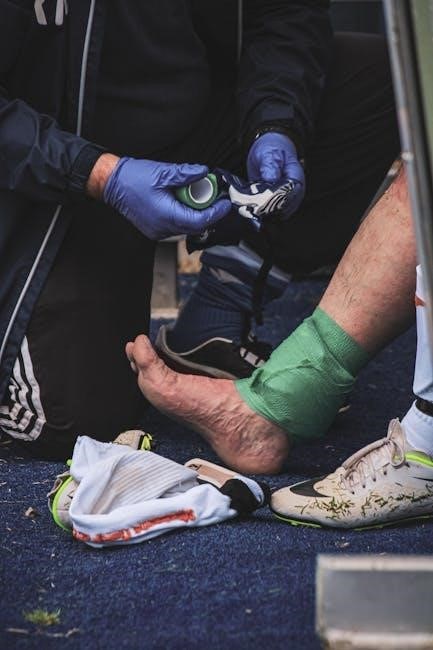
compression socks mmhg guide
Compression socks are specialized garments designed to improve blood flow using graduated pressure, measured in mmHg, to support leg health and alleviate discomfort.
1.1 What Are Compression Socks?
Compression socks are tight-fitting garments that apply graduated pressure, starting strongest at the ankle and decreasing upward. They are designed to enhance blood flow, reduce swelling, and provide support to legs. Made from elastic materials, they are used for both medical and non-medical purposes, such as alleviating varicose veins or improving athletic performance. Available in various compression levels (measured in mmHg), they cater to different needs, from mild support to firm medical-grade compression.
1.2 Benefits of Using Compression Socks
Compression socks offer numerous benefits, including improved blood circulation, reduced leg swelling, and enhanced comfort. They alleviate symptoms of varicose veins, edema, and fatigue, making them ideal for athletes, travelers, and individuals with medical conditions. By providing graduated pressure, they help prevent blood pooling and promote venous return, which can reduce the risk of deep vein thrombosis. Regular use can also enhance muscle recovery and provide support during prolonged standing or physical activity, improving overall leg health and well-being.
Understanding mmHg in Compression Socks
mmHg measures the pressure exerted by compression socks, indicating their tightness. Higher mmHg levels provide firmer compression, essential for addressing specific medical conditions and improving blood flow effectively.
2.1 What Does mmHg Mean?
mmHg stands for millimeters of mercury, a unit measuring the pressure exerted by compression socks. It indicates how tightly the socks hug the legs, gradating from ankle to calf.
2.2 How Compression Levels Are Measured
Compression levels in socks are measured in mmHg, with pressure highest at the ankle and decreasing towards the calf. This graduated compression helps improve blood flow.

Compression Levels Guide
Compression socks are available in varying mmHg levels, from mild to extra-firm, each designed to address specific needs, improving circulation and reducing swelling effectively.
3.1 Mild Compression: 8-15 mmHg
Mild compression socks with 8-15 mmHg are ideal for light support, reducing fatigue, and enhancing circulation. They are perfect for everyday wear, especially for individuals seeking subtle leg support without medical necessity. These socks are great for preventing swelling during travel or standing for long periods. They are gentle on the skin and suitable for people who are new to compression therapy, offering comfort and relief without feeling too restrictive.
3.2 Moderate Compression: 15-20 mmHg
Moderate compression socks with 15-20 mmHg provide a balance between support and comfort, making them suitable for managing mild to moderate circulatory issues. They are often recommended for individuals with varicose veins, swelling, or those recovering from surgery. This level helps reduce leg fatigue, improves blood flow, and is ideal for athletes or frequent travelers. It offers enough pressure to address medical concerns while remaining comfortable for daily use, making it a popular choice for long-term wear.
3.3 Firm Compression: 20-30 mmHg
Firm compression socks with 20-30 mmHg are designed for moderate to severe circulatory conditions. They are often prescribed for post-surgery recovery, deep vein thrombosis, or significant varicose veins. This level provides strong support, reducing swelling and promoting blood flow. It is ideal for individuals with chronic venous insufficiency or those needing higher pressure for medical conditions. While more restrictive, they remain wearable for extended periods with proper sizing, offering therapeutic benefits for serious leg health issues.
3.4 Extra Firm Compression: 30-40 mmHg
Extra firm compression socks at 30-40 mmHg are the strongest option, typically recommended for severe medical conditions like chronic venous insufficiency or lymphedema. They provide intense pressure to assist blood flow and reduce significant swelling. These are usually prescribed by doctors and are designed for individuals with advanced circulatory issues. While they offer maximum support, they can be challenging to put on and are generally worn under medical supervision to ensure safety and effectiveness.

How to Choose the Right mmHg Level
Selecting the correct mmHg level involves considering your medical condition, severity of symptoms, and lifestyle. Consult a healthcare professional to ensure the best fit for your needs.
4.1 Factors to Consider
When selecting the right mmHg level, consider your medical condition, symptom severity, and lifestyle. For example, athletes may prefer 15-20 mmHg for performance, while those with varicose veins or DVT may need higher levels. Activity level, occupation, and travel frequency also play a role. Mild symptoms like swelling may require 8-15 mmHg, while severe conditions like edema necessitate 30-40 mmHg. Consulting a healthcare professional ensures the best fit for your specific needs and health status.
4.2 How to Measure Compression Levels
Compression levels are measured in mmHg, indicating the pressure exerted by the socks. Graduated compression means the pressure is highest at the ankle and decreases upward. To measure accurately, ensure the socks fit properly and the mmHg rating aligns with your needs. Use a size chart to confirm fit, as improper sizing can lead to incorrect pressure. Always refer to the manufacturer’s guidelines and consult a professional for precise measurement and recommendations tailored to your condition.

Benefits of Compression Socks
Compression socks enhance blood circulation, reduce leg fatigue, and alleviate swelling. They are ideal for athletes, travelers, and individuals with medical conditions like varicose veins or edema.
5.1 Medical Benefits
Compression socks offer significant medical benefits, particularly for individuals with venous insufficiency, varicose veins, and deep vein thrombosis. They improve blood flow, reduce swelling, and prevent blood pooling in the legs. Higher mmHg levels, such as 30-40 mmHg, are often prescribed for chronic conditions, while lower levels like 15-20 mmHg are effective for mild symptoms. They are also recommended for post-surgery recovery and managing edema in diabetic patients. Regular use can enhance overall circulatory health and alleviate discomfort associated with these conditions, promoting faster healing and reducing the risk of complications. By providing graduated compression, these socks ensure optimal support and relief, making them a vital tool in both preventive and therapeutic care. This makes them an essential component in managing various vascular-related health issues effectively.
5.2 Non-Medical Uses
Compression socks are widely used for non-medical purposes, such as enhancing athletic performance, improving comfort during travel, and reducing leg fatigue in active individuals. Athletes and runners benefit from improved blood flow, which aids in muscle recovery and reduces soreness. Frequent travelers use them to prevent swelling during long flights or drives. Additionally, compression socks are popular for hiking and standing jobs, as they provide support and comfort. Their versatility makes them a practical choice for everyday activities, promoting energy and reducing discomfort, regardless of medical needs. This versatility highlights their universal appeal and practicality for various lifestyles and activities, making them a valuable accessory for both medical and non-medical purposes alike. By offering graduated compression, these socks ensure optimal comfort and support, catering to a wide range of needs and preferences. Their popularity extends beyond medical use, proving their effectiveness in enhancing overall well-being and performance in daily life.

How Compression Socks Work
Compression socks use graduated compression technology, applying the highest pressure at the ankle, gradually decreasing towards the top, to enhance blood flow and reduce swelling.
6.1 Graduated Compression Technology
Graduated compression technology in socks applies varying pressure, starting with the highest mmHg at the ankle and gradually decreasing toward the top. This design enhances blood flow by assisting the veins in returning blood to the heart more efficiently. The compression is strongest at the ankle, typically ranging from 20-30 mmHg, and becomes lighter as it moves up the leg. This technology helps reduce swelling, alleviates fatigue, and improves overall circulation, making it essential for both medical and athletic purposes.
6.2 Improving Blood Flow
Compression socks enhance blood flow by applying graduated pressure, which helps push blood upward against gravity. The tighter compression at the ankle, measured in mmHg, prevents blood from pooling in the legs. This promotes efficient blood return to the heart, reducing swelling and fatigue. By improving circulation, compression socks alleviate symptoms of varicose veins, edema, and other vascular conditions, while also boosting energy levels and overall leg comfort throughout the day.
Who Can Benefit from Compression Socks?
Athletes, individuals with varicose veins, pregnant women, frequent travelers, and those with circulatory issues can benefit from compression socks to reduce swelling and improve blood flow effectively.
7.1 Athletes and Runners
Athletes and runners benefit from compression socks as they improve blood circulation, reducing muscle fatigue and enhancing performance. The graduated compression technology provides tighter support at the ankle, gradually decreasing toward the knee, which helps prevent swelling and promotes faster recovery. Many athletes opt for 15-20 mmHg or 20-30 mmHg levels to balance support and comfort during intense physical activity, making them an essential accessory for training and competitions.
7.2 People with Varicose Veins
Individuals with varicose veins find relief through compression socks, which help reduce swelling and alleviate discomfort. The graduated pressure improves blood flow, preventing blood pooling in affected veins. Typically, a moderate compression level of 15-20 mmHg is recommended for mild cases, while higher levels like 20-30 mmHg are prescribed for more severe conditions to provide additional support and assist in managing symptoms effectively.
7.3 Pregnant Women
Compression socks are highly beneficial for pregnant women, helping to reduce swelling and alleviate edema in the legs. The graduated pressure improves blood circulation, which is essential during pregnancy when blood volume increases. Mild to moderate compression levels, typically 15-20 mmHg, are often recommended to provide comfort and support without restricting movement. They can also help prevent blood from pooling in the legs, a common issue during pregnancy. Consulting a healthcare provider ensures the right compression level is chosen for individual needs.
7.4 Frequent Travelers
Compression socks are a valuable companion for frequent travelers, especially during long flights or car rides. They help prevent swelling and blood pooling in the legs, common issues during prolonged sitting. Mild to moderate compression levels, such as 8-15 mmHg or 15-20 mmHg, are ideal for travelers to enhance blood flow and reduce fatigue. The graduated pressure ensures comfort and support, making travel more enjoyable and promoting overall leg health during and after the journey.
How to Wear Compression Socks Correctly
Put on compression socks first thing in the morning when legs are least swollen. Ensure a snug fit without bunching or rolling, and smooth out fabric for even pressure distribution.
8.1 Proper Fit and Sizing
Proper fit is crucial for compression socks to work effectively. Choose a size that provides snug support without feeling too tight or constricting. Socks should fit comfortably, with the highest pressure at the ankle gradually decreasing up the leg. Avoid bunching or rolling, as this can cause discomfort or restrict blood flow. Start with a lower compression level if you’re new to wearing them, and consult a size chart to ensure the best fit for your leg measurements.
8.2 Putting Them On and Taking Them Off
Putting on compression socks requires care to ensure proper fit and avoid damage. Start by gathering the sock at the toe and gently roll it up, working your way to the top. Avoid pulling too hard, as this can stretch or tear the fabric. Use a donning glove or assistive device if needed. To remove, reverse the process by rolling the sock down from the top. This ensures even pressure distribution and prevents discomfort.
Common Mistakes to Avoid
Avoid choosing the wrong compression level, improper sizing, and ignoring graduated compression technology. Incorrect use can reduce effectiveness or cause discomfort, so proper fitting is essential.
9.1 Choosing the Wrong Compression Level
Selecting the incorrect compression level is a common mistake. Compression levels, measured in mmHg, vary from mild (8-15 mmHg) to extra firm (30-40 mmHg). Choosing a level too high can cause discomfort or restrict blood flow, while a level too low may not provide adequate support. It’s essential to match the mmHg level to your specific needs, such as medical conditions or activity level. Consulting a healthcare professional ensures the right compression level for optimal benefits and comfort.
9.2 Improper Sizing
Improper sizing is another frequent error. Compression socks must fit snugly but not too tight. Ill-fitting socks can cause discomfort, restrict movement, or reduce effectiveness. Measuring calf and ankle circumference ensures the correct size. Socks that are too small may cut off circulation, while overly large ones may not provide sufficient support. Always refer to the manufacturer’s sizing chart and guidance to select the appropriate fit for optimal comfort and therapeutic benefits.
Compression socks are a versatile and effective solution for improving blood flow, reducing discomfort, and addressing various medical conditions. By understanding mmHg levels and proper sizing, individuals can maximize benefits. Whether for medical needs, athletic performance, or everyday comfort, compression socks offer tailored support. Always consult a guide or professional to ensure the right fit and compression level for optimal results and long-term leg health.

